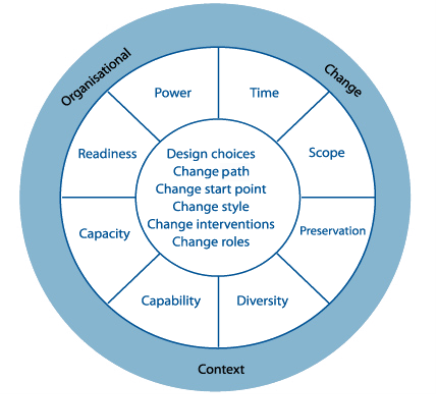Organizational change is an essential part of today’s globalized work life. In modern’s economy, teams and organisations face rapid change like never before. Globalization has not only boosted the markets and opportunities for more development and profit, it also provides opportunities for organisational members to process. However, in general, change processes make demands on both employees and management, regardless of the content of the change process. Facing of the tide of globalization, one of the dominant disputes that human resource professional’s face is what method to improve organizational competitive advantage in the hastily changing environment. Organisational change come about multiple reasons, it is undertaken to ameliorate the accomplishment of that particular organization or a portion of the organization, for instance, a process or team. For organisations to be able to prosper, it is essential for them to go through an important alteration at different sections during their growth. Significant organizational Continue reading
Change Management
Kotter’s Eight Step Change Model – Explained
Organizational change is described as the shift of the behavior of the whole organization, to one degree or another. One should understand that change is not that can immediately occurs, ought to be intended and planned process to maintain an organization practical and existing. Three categories of organizational change are; Development change is that change where organization try perform better what they all ready performing. Transitional change is that change in which organization implement totally new methods replacing old ones. Transformational change is that change where organization do major overhauling of its structure, vision and strategy and change bring evolution in the organization. Managing culture in the organization is very important these days when every day new technology is coming and there is so much competition in the market to stay on the top. Organizations are going through a big cycle of cultural change these days from daily tasks to Continue reading
Change Kaleidoscope – Change Management Models
Due to growing of globalization, advance technology, and organizational consolidation, change is nowadays become a crucial part of every organization in order to survive in changing business environment. To handle the change, change management is required in transitioning for both organizational and individual level to attain future desired change. Change at organizational level is related to strategy which will indicate organizational direction and activities. In developing effective organization strategy, both internal and external environments have to be taken into consideration. When the strategy has been changed as adapting to changing internal and external environments, strategic change is necessity to be utilized in change management in order to align change with developed strategy. As individual change is pivotal part of organization change, change management need to be adopted at individual level in order to initiate the change and consequently obtain successful organization change. Change Kaleidoscope was produced by Hope Hailey & Continue reading
Change Management Models – The Satir Change Model
Managing change in today’s organizations is not easy but doing it well is the new imperative. If companies want to survive and strive in today’s highly competitive environment, they have change quickly and yet successfully. Managing changes is now a core competency where organizations fall short in the race to adopt it. The increasing pace of change coupled with accelerating uncertainty. Change is something that makes people upset and has the higher potential of failures, loss production or failing quality. On the other end, there is a positive side of change, where the effects of change are important to the survival of the organization. From the perspective of employees both definition and understanding is essence to successfully managing change. As mentioned before uncertainty, a fear of unknown or an expectation of loss make people resistant to change. To eliminate this discomfort we have to make sure that people perceive the Continue reading
Resistance to Change in Organizations
The main reason for the failure of many change initiatives can be found as the resistance to change. Resistance to change is costly and time consuming into the change process which means long or short delays in any process of change that are difficult to anticipate but must be taken into consideration. Resistance has also been considered as a source of information, being useful in learning how to develop a more successful change process. Undoubtedly, resistance to change is a key topic in change management and should be seriously considered to help the organization to achieve the advantages of the transformation. Resistance to change is an ongoing problem. At both the individual and the organizational levels, resistance to change impairs concerted efforts to improve performance. Many corporate change efforts have been initiated at tremendous cost only to be halted by resistance among the organization’s employees. Organizations as a whole also Continue reading
Forces for Organizational Change
Change is inevitable in the life of an individual or organisation. In today’s business world, most of the organisations are facing a dynamic and changing business environment. They should either change or die, there is no third alternative. Organisations that learn and cope with change will thrive and flourish and others who fail to do so will be wiped out. The major forces which make the changes not only desirable but inevitable are technological, economic, political, social, legal, international and labor market environments. Recent surveys of some major organisations around the world have shown that all successful organisations are continuously interacting with the environment and making changes in their structural design or philosophy or policies or strategies as the need be. There are a number of factors both internal and external which affect organisational functioning. Any change in these factors necessitates changes in an organisation. The more important factors are Continue reading



